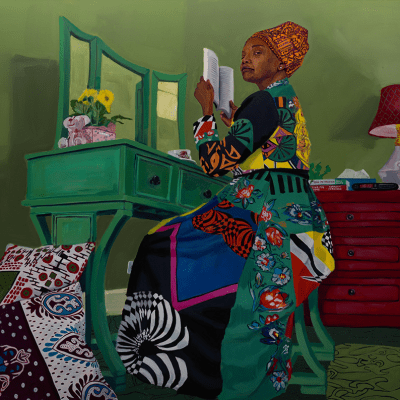
As the highly anticipated portraits of former president Obama and first lady Michelle are unveiled at the Smithsonian’s National Portrait Gallery on Monday morning, history is made. Amy Sherald and Kehinde Wiley, personally selected by the Obamas, are the first African-Americans commissioned to paint official presidential portraits.
The artists of choice are stirring conversations nationwide, as the Obamas did not take the traditional route when it came to their official portraits. Yet, in their own strikingly unique way, Kehinde Wiley and Amy Sherald have managed to blend traditional elements with a contemporary style, which is quite refreshing, to say the least.
Renowned painter Kehinde Wiley, famous for his vivid and royal depictions of African-Americans, was Obama’s first choice for his official presidential portrait, out of dozens of candidates. “What I was always struck by when I saw his portraits was the degree to which they challenged our ideas of power and privilege,” Obama said during the unveiling on Monday, explaining his choice of Wiley. The life-sized oil painting shows Obama sitting on a wooden armchair, with his demeanor indicating the cool, calm, and collected nature that so often defined the 44th president. Yet, there is sternness here, too–perhaps to suggest complexity and the multifaceted nature of human beings. Surrounding Obama is an intricate background of green foliage and specific flowers, each symbolizing his roots: jasmine signifies Hawaii, his birthplace, the African blue lilies represent Kenya, his father’s birthplace, and the chrysanthemums are the official flower of Chicago, his adopted home.
In contrast to Wiley’s established fame, the unveiling of Amy Sherald’s Michelle Obama’s portrait is the Baltimore-based artist’s first time in the national spotlight. But make no mistake–Sherald is rapidly rising as an artist, and was recently awarded the High Museum of Art’s David Driskell Prize. The 44-year-old paints her African-American subjects with ambiguous gray skin, while vibrantly detailing all other qualities within the painting, such as the background and clothing. Sherald has explained that the use of gray is “A way for me to subversively comment about race without feeling as though I’m excluding the viewer.” Staying true to her trademark style for former first lady Michelle’s official portrait has both confused and sparked a buzzing curiosity among those unfamiliar with Sherald’s body of work.
In the portrait, Michelle wears a floor-length gown, mostly white, with muted patches of striped colors that compliment well with the light blue backdrop. Michelle is illustrated with grace and elegance, surely, but what’s lacking here is the fierce, bold nature of our former first lady. In comparison to Sherald’s other works, which are generally more daring and vibrant in nature, Michelle appears to be a bit muted in both color and emotion. To depict such a dynamic and powerful woman as “muted,” this may be seen as problematic to some. To others, it’s a matter of personal taste, and doesn’t in any way discredit Sherald as a phenomenal artist that is absolutely deserving of this high honor.
Michelle’s choice of a rising artist speaks volumes about her character, and celebrates black artists from all walks of life. During the unveiling, the former first lady discussed the impact that Sherald’s portrait will have on young girls and girls of color. “They will see an image of someone who looks like them hanging on the walls of this great American institution … And I know the kind of impact that will have on their lives because I was one of those girls,” she said.
Both portraits will be on display at the Smithsonian’s National Portrait Gallery, open for public viewing beginning Tuesday. Obama’s portrait will permanently reside in the hall of presidents, and Michelle’s will temporarily live in a separate gallery, available for viewing until November.







